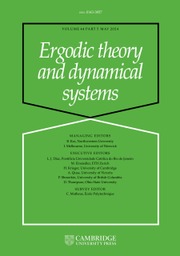Crossref Citations
This article has been cited by the following publications. This list is generated based on data provided by Crossref.
Guillemin, Victor
and
Sternberg, Shlomo
1984.
Multiplicity-free spaces.
Journal of Differential Geometry,
Vol. 19,
Issue. 1,
Holm, Darryl D.
Marsden, Jerrold E.
Ratiu, Tudor
and
Weinstein, Alan
1985.
Nonlinear stability of fluid and plasma equilibria.
Physics Reports,
Vol. 123,
Issue. 1-2,
p.
1.
Adams, M. R.
Harnad, J.
and
Previato, E.
1988.
Isospectral hamiltonian flows in finite and infinite dimensions.
Communications in Mathematical Physics,
Vol. 117,
Issue. 3,
p.
451.
Wurzbacher, T.
1990.
On a conjecture of Guillemin and Sternberg in geometric quantization of multiplicity-free symplectic spaces.
Journal of Geometry and Physics,
Vol. 7,
Issue. 4,
p.
537.
Paternain, Gabriel P.
1992.
On the topology of manifolds with completely integrable geodesic flows.
Ergodic Theory and Dynamical Systems,
Vol. 12,
Issue. 1,
p.
109.
Paternain, Gabriel P.
1993.
Multiplicity two actions and loop space homology.
Ergodic Theory and Dynamical Systems,
Vol. 13,
Issue. 1,
p.
143.
Paternain, Gabriel P.
1994.
On the topology of manifolds with completely integrable geodesic flows II.
Journal of Geometry and Physics,
Vol. 13,
Issue. 3,
p.
289.
Prykarpatsky, Anatoliy K.
and
Mykytiuk, Ihor V.
1998.
Algebraic Integrability of Nonlinear Dynamical Systems on Manifolds.
p.
303.
Болсинов, Алексей Викторович
Bolsinov, Aleksei Viktorovich
Йованович, Бошко
and
Jovanovic, Bosko
2001.
Интегрируемые геодезические потоки на однородных пространствах.
Математический сборник,
Vol. 192,
Issue. 7,
p.
21.
Foth, Philip
2002.
Bruhat Poisson structure on CPn and integrable systems.
Journal of Mathematical Physics,
Vol. 43,
Issue. 6,
p.
3124.
Khesin, Boris
and
Misiołek, Gerard
2003.
Euler equations on homogeneous spaces and Virasoro orbits.
Advances in Mathematics,
Vol. 176,
Issue. 1,
p.
116.
Bolsinov, Alexey V.
and
Jovanović, Božidar
2003.
Noncommutative Integrability, Moment Map and Geodesic Flows.
Annals of Global Analysis and Geometry,
Vol. 23,
Issue. 4,
p.
305.
Foth, Philip
and
Lozano, Guadalupe
2004.
The Geometry of Polygons in ℝ5 and Quaternions.
Geometriae Dedicata,
Vol. 105,
Issue. 1,
p.
209.
Butler, Leo T.
2005.
Manifolds of infinite topological type with integrable geodesic flows.
manuscripta mathematica,
Vol. 116,
Issue. 1,
p.
99.
Kostant, Bertram
and
Wallach, Nolan
2006.
Studies in Lie Theory.
Vol. 243,
Issue. ,
p.
319.
Maciejewski, Andrzej J.
and
Przybylska, Maria
2008.
Differential Galois obstructions for non-commutative integrability.
Physics Letters A,
Vol. 372,
Issue. 33,
p.
5431.
LÁZARO-CAMÍ, JOAN-ANDREU
and
ORTEGA, JUAN-PABLO
2009.
REDUCTION, RECONSTRUCTION, AND SKEW-PRODUCT DECOMPOSITION OF SYMMETRIC STOCHASTIC DIFFERENTIAL EQUATIONS.
Stochastics and Dynamics,
Vol. 09,
Issue. 01,
p.
1.
Jovanović, Božidar
and
Jovanović, Vladimir
2015.
Contact flows and integrable systems.
Journal of Geometry and Physics,
Vol. 87,
Issue. ,
p.
217.
Dobrogowska, Alina
and
Ratiu, Tudor S.
2015.
Integrable Systems of Neumann Type.
Journal of Dynamics and Differential Equations,
Vol. 27,
Issue. 3-4,
p.
533.
MYKYTYUK, IHOR V.
2016.
INTEGRABILITY OF GEODESIC FLOWS FOR METRICS ON SUBORBITS OF THE ADJOINT ORBITS OF COMPACT GROUPS.
Transformation Groups,
Vol. 21,
Issue. 2,
p.
531.

